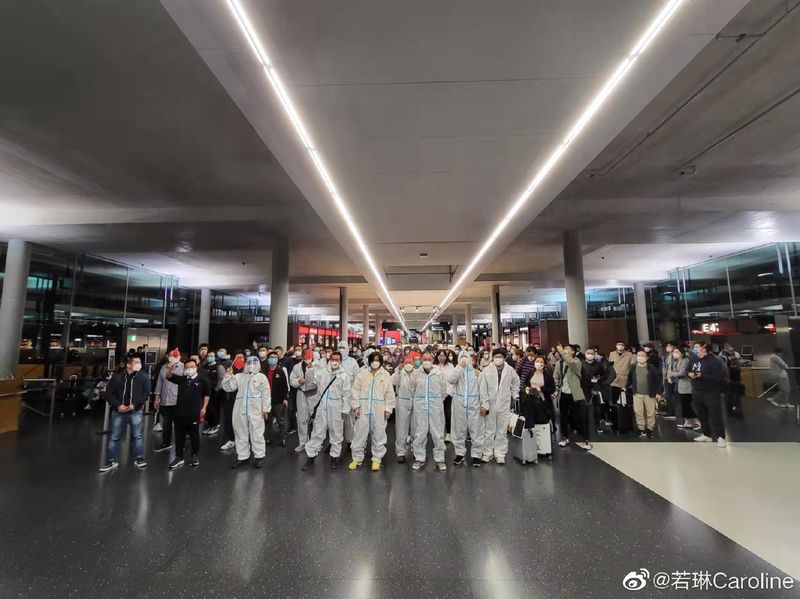Flight cancellations, strict testing requirements, and sky-high ticket prices leave hundreds stranded in Europe
When Shanghai officials announced a two-stage lockdown of the city between March 28 and April 5, Song Yang felt the effects over 9,000 kilometers away. As she tried to board her flight from Zurich to Shanghai’s Pudong airport at around 7 p.m. (midnight in Shanghai) on March 28, she saw a crowd of people around the gate—the flight had been canceled.
With Covid-19 cases surging, Shanghai had locked down half of the city east of the Huangpu River, where the Pudong airport (one of the busiest in the world) is located, until April 1. That left many Chinese, like Song, stranded as their flights were canceled or rerouted. At the time of writing, between Song’s flight from Zurich, and another from Frankfurt that a passenger publicized on Weibo, over 350 passengers have been left at both airports without a route back to China.
But this is a not a new phenomenon. For nearly as long as the pandemic has raged since early 2020, those trying to return to China from abroad have struggled with canceled flights, strict Covid testing policies, visa extensions, and ticket prices that can run to hundreds of thousands of yuan.
Previously, on February 8, 50 passengers got stuck at Copenhagen Airport when they tested positive for Covid-19 when transiting en route from London to China. Their second tests were all negative, but by the time the results came in, their connecting flight had left.
Chinese media outlet Hongxing News reported that the passengers stayed in the airport for four days before the local embassy finally arranged hotels for them. They eventually left for China on another flight on February 15. On March 19, a similar group of passengers stuck at Vienna airport in Austria also went viral on Weibo.
According to UNESCO, there are around 1 million Chinese students who study abroad, with European countries among their most popular destinations. Travelers stuck in airports due to canceled flights to China from the US, Canada, and Australia have also been reported on Chinese social media.
At the time of writing, the hashtag “Chinese students stuck at Zurich airport” has over one million views on Weibo, while “Chinese students stuck at Frankfurt airport” has almost 700,000. In videos that spread on the microblogging site, passengers at the Zurich airport shouted “We want to go back to China!” and chanted the national anthem while holding Chinese flags.

Chinese students stuck at Zurich airport after their flight was canceled (Weibo user: 若琳Caroline)
Song, an undergraduate who studies hotel management in Switzerland, was hoping to return home to get treatment for her recently diagnosed Type 1 Diabetes. “It’s very difficult for me to get treatment in Switzerland, as I don’t speak French or German,” she tells TWOC.
She spent almost 60,000 yuan on this journey, including 43,000 yuan for the flight ticket from Zurich to Shanghai, plus the two Covid-19 tests that the Chinese embassy requires within 48 hours of the flight. The ticket should be refunded to her, but the money she spent on the Covid tests, accommodation, transportation to the airport, and luggage shipping is gone.
Since the pandemic began, international flights to China have been severely curtailed as government policies restricted the number of arrivals and imposed strict requirements for pandemic prevention, including banning airlines from running routes for weeks if they record positive cases on a flight. Airlines have voluntarily canceled routes to and from China as demand initially plummeted.
According to the Civil Aviation Administration of China’s (CAAC) “circuit breaker” policy introduced in June 2020, and updated in April 2021, any flight that has between five and nine infected passengers when entering China can choose either to temporarily halt the route, or operate at 40 percent capacity for four weeks. If the flight has more than this number of infected passengers, the route will be suspended for four weeks or more, depending on how many cases are found.
Just between June and August 2021, the CAAC reported that the number of international flights to China fell by 621 due to these measures. Last September Shang Kejia, a spokesperson for CAAC, said in a press conference there were around 200 international flights into China each week, just 2.2 percent of the pre-Covid total.
This has meant sky-high prices for international flights to China, and a web of bureaucracy for travelers to navigate before they touch down in the PRC. Yan, a 25-year-old student, who asked to be identified only by her surname, has been on an exchange program at Eberhard Karls University in Tübingen, Germany, and has attempted to fly back to China four times since her program ended in February. Each time her flight has been canceled, most recently the one from Frankfurt. “I had booked the hotel and done the tests they asked, but the flight was canceled again while I was on the train to the airport,” Yan tells TWOC.
Song isn’t as anxious as some of the others. “Compared with other passengers, my situation is not that bad because my disease is not that serious,” she says. “But lots of people have risked everything [to try and get this flight]. They have no place to return to because they have canceled their accommodation here and they no longer have valid residency,” she continues, referring to their expiring visas. Yan has seen her visa recently expire, though she has been granted a temporary replacement visa which runs until April 22.
Even if the flight isn’t canceled, getting on a plane from abroad to China is complex. Though the specific policies the Chinese government imposes on flights from different countries varies, in Europe a typical process involves buying a plane ticket, getting both a negative nucleic acid and antibody test within 48 hours of the flight, then submitting the results to the local Chinese embassy to check and provide the traveler with a “green code” that they can use to board the plane. If transiting in a country, travelers have to do two further nucleic acid tests and provide negative results before boarding their connecting flight. On arrival in China, they need to enter centralized quarantine for at least 14 days.
These complex procedures have made some overseas students, workers, and celebrities charter planes to fly home, with fees ranging from 400,000 yuan for a 13-person flight-share to 4 million yuan for a direct flight for a single passenger, according to a May 2020 blog post on a website for Chinese living in North America, which cites sources including a spokesperson from New York-based charter flight company Airacer and a vlogger who organized one such flight that month. The post also states that Chinese embassies in the US and UK have chartered flights home for students, who had to pay between 20,000 to 70,000 yuan for a seat.
“I was very anxious when planning on going back to China. The expensive plane tickets, the fussy preparations, and the chance to be stuck in the transiting airport—there were so many uncertainties,” Fan Xia, a social media manager based in London, tells TWOC, adding she hasn’t been able to return to China for the past two years. She stopped trying after a flight she booked was canceled last December because of the “circuit breaker” policy.
Flying from the UK has become even more difficult since March 23, when the Chinese embassy in London announced that travelers needed to present their negative nucleic acid test to the embassy within 12 hours of their flight, rather than the previous 48 hours, and submit the test result before 9 p.m. The embassy states that its staff require at least three hours to process each request, leaving little time to take the test, then get the results and embassy approval before boarding the plane.
“It’s impossible,” says Tilda Liu, a Chinese student in London whose flight is scheduled for May. “My flight will depart at 8 in the morning, which means I must do the test after noon the previous day, and I need to submit the results to [the embassy] before 9 in the evening…I don’t know of any [testing] services that could give the results in half a day.” The embassy’s website suggests passengers use an express testing service that costs 318 British pounds (over 2,500 yuan).
Throughout their ordeal, both Song and Yan say they received little help from the local Chinese embassies or airlines. The airlines told them their flights were canceled because of the lockdown in Shanghai while local Chinese embassies had no solutions, only sympathy. “No one is helping us...[The airline] and the local embassy are blaming each other, and it has been very difficult to call them,” Yan claims.
Liu says she has been suffering from “mental anxiety” because her visa expired on April 1. She has applied for “exceptional assurance” from the UK Home Office to stay in the country beyond that date, but feels uncomfortable about the prospect of being in the country illegally without a way home. “It’s like you are abandoned by both sides.”












